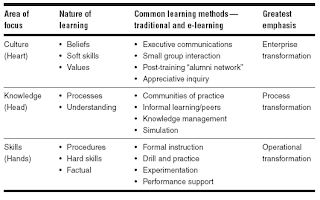5C Coaching: the sage not on the stage, but the guide by the sideE-learning of the 2nd generation is not synonymous to self-study as such. The function of ‘coaching’ is to identify the specific needs of the learner, selecting the proper learning materials, offer them in a coherent way and build competences and skills that help the learner to make the transition from ‘knowing’ to ‘can do’ and finally to ‘can adjust and adopt’. The proof of the pudding is not only in a certificate but in the actual integration of the output of learning into the task on hand. Formal learning up till now has primarily been based on courses. Standard taxonomies can be consulted for drawing up profiles of learners of whom the performance is clearly described. It is up to the learners to select from the range of objectives and improve these skills and competences. The expertise of the coach lies in a well-considered selection of options for a specific (group of) learner(s), to organize the input and to systematise the output. For formal ways of learning, we can summarise it in an SOS approach (Select, Organise, Systematise), containing the following steps:
- Mapping: based on a needs analyses, training modules are suggested The personal learning style of a learner is considered and learning strategies are acquired to improve the efficiency and effeciveness of learning. Examples of mapping are placement tests, roadmaps, info sessions, personalised learning paths, schooling options, a transparent cataloguing, etc. Vice versa, the typical learner is guided to standard and customized contents.
- Enrollment: once the student has been allocated the proper contents, a formal registration takes place. Registration happens on line and automatically with the necessary checking and red tape which might hamper a swift transition. Approvals from management, budgets, payment and profile controls, accounts and passwords are indeed part of the game.
- Orientation: orientation should not be overlooked in e-learning. It is the mental script of learning. The expectations on the part of the student vis a vis the course, the e-learningplatform, the ease of learning, the coaching should be compliant with the offer to ensure a smooth and swift progress. Coaching needs to be pro-active and thus the first step needs to be taken by the coach. An example of orientation is mailing ‘step-by-step’ documents, organise a kick-off session, show examples of good practice and demos, give tips as to timing, provide extra references, inform about ‘learning how to learn’, etc.
- Study: the obvious part of coaching is the follow-up and feedback, partially by asking and answering questions but here collaborative learning should be stimulated, It is the group that should perform and that should sustain the learning community. Coaching and interaction will evoke involvement and comitment. Examples are: moderated discussion for a, e-mail support, walk-in question sessions, FAQ-sessions, extra exercises, quizes and games with reward.
- Evaluation: the traditional evaluation upon completion of the course will measure the level of satisfaction of the different course contents and features as well as the learning results. Typical questionnaires with a Likert-scale are a good starting point to improve the project. Also exams and formal certificates belong here.
- Maintenance: More and more organisations wonder what happens after the training. How is knowledge shared? How will innovation be sustained and quality improved? Sustainability is therefore essential for 2nd generation e-learning. Here again, it is not the e in the e-learning that will be crucial but the effect of the learning, how people learn to adopt and adapt the new information. Examples of maintenance are updating courses, membership of a community concerning the topic or open access to discussion fora and the course.
For more informal ways of learning other approaches can be used, such as a learning portfolio, performance support systems or other. Portfolios may practically translate learning paths and outcomes of a learner. In portfolios (e.g. the European Language Portfolio ELP), learners keep track of their identity (passport), their learning process (biography) and their achievements (dossier with stocktaking).




